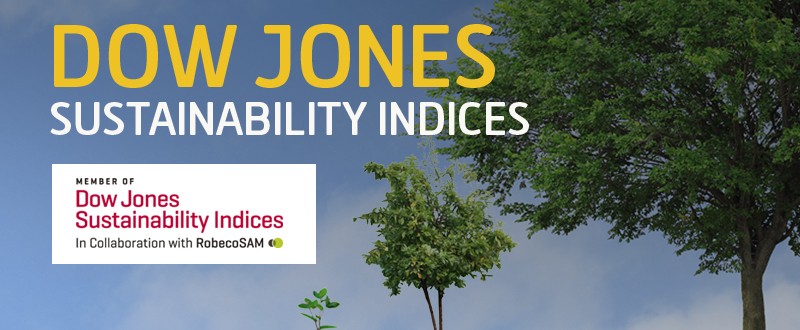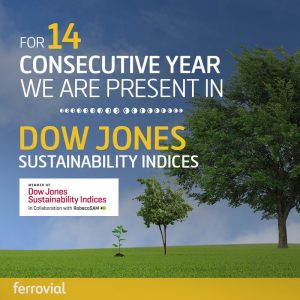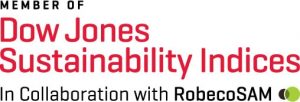
This year and like every year around these dates we at Ferrovial await the results of the analysis conducted by RobecoSAM – who have evaluated our continuity in the Dow Jones Sustainability Index (DJSI) family – with enthusiasm and a bit of excitement. Finally, on Thursday September 10, we had received confirmation that we will continue to be a part of the family, meaning our presence in the sustainability index will already stretch for 14 consecutive years! A fact that is becoming increasingly complex, as our competitors continue to catch up steadily and, forgive the repetition, this results therefore in very high levels of competition.
Over the past three years, Ferrovial has been the only Spanish company within its sector (Engineering & Construction) that has been included in this index. This does not mean that companies that no longer belong to it are underperforming, but that those that were selected by the index have just outperformed the rest in terms of sustainable development or, more clearly, have improved their results with respect to the previous year. Among the details of this good performance is Ferrovial’s updating of its Code of Ethics and Quality and Environmental Policy in 2014. In addition, we have also published a series of policies related to the company’s good conduct, namely in the field of Corporate Responsibility, Human Rights, Anti-corruption and Competition, following along the lines of our Corporate Responsibility Strategic Plan ‘Plan 20.16’. Much emphasis has been placed on achieving the goals that had been set in the Plan, as all corporate areas take part in it and the Plan itself is aligned with the business strategy. This is a characteristic that makes our ability to develop our sustainability model possible together with the support from top management.
What is the origin of the Dow Jones Sustainability Index?
In order to understand how this index works let us start at the beginning. The family of the Dow Jones sustainable indices was created in September 1999 with the purpose of reflecting the top, large company performers in terms of economics, social and environmental aspects. This family, which consists of several indices that are based on global, regional and national benchmarks, has grown and become diversified through the years with the creation of specific indices at the regional and even the industry level. It arrived in Europe in 2001 with the creation of several regional indices (DJSI Europe and DJSI Eurozone). The last ones that were created were the DJSI Emerging Markets and the DJSI Australia. Today, this set of indices constitutes a clear and sound benchmark for large investors.
Company selection process steps of the Dow Jones Sustainability Index
- The process begins with a large universe of companies (approximately 10,000 companies from the S&P Global BMI, Broad Market Index).
- From this initial scenario and following the criteria established by the S&P, the number of companies is reduced to about 3,400, which then make up the total eligible universe for the full family of indices. Next, about 2,500 companies are invited to participate in the selection process for the world index, which are selected according to market capitalization criteriaor degree of representativeness within their sector.
- Companies are ordered according to the GICS, Global Industry Classification Standard adopted in 2012 as part of the integration process between S&P and Dow Jones. The GICS comprises 24 Industry Groups, which in turn are divided into 59 sectors (Industries) into which all of the companies from the eligible universe are classified.
- Companies must then complete a form. RobecoSAM uses a methodology that is based on the CSA (Corporate Sustainability Assessment). This system is based on 59 different questionnaires depending on the sector under which the company has been classified. There are a number of questions that are the same across all sectors and a group of specific questions according to the risks of the sector. The questionnaire, which has about 100 questions, is divided into the three dimensions that sustainability encompasses:
- economic, by analyzing aspects pertaining to corporate governance and code of conduct, corruption and competition, risks and supply chain management;
- environmental, by measuring the level of management activity conducted by the company in terms of efficiency, management and strategy with respect to its setting;
- and social, by examining compliance with human rights, treatment to employees and their health and safety conditions.
The questionnaires inquire about those topics that are relevant to the sector and that might cause a material impact; in all, they inquire about the companies’ long-term value contribution. Each question has its own relative weight as a function of its importance within the sector and stakeholders’ expectations.
- In addition to the questionnaire, the agency conducting the analysis examines the corporate documentation supplied by candidate companies and monitors and analyzes all relevant aspects in the media in order to measure their reputation.
- Once all of the information has been analyzed, ‘best-in-class’ criteria is used to obtain the results, which means you are being measured against the best companies in your sector and therefore, although your sustainability performance may be good, other companies may end up performing better than you, resulting in your company being left out of the selected group of companies. At this point it is very important to remember that the criteria used by other agencies conducting the analyses for the other indices are not the same and therefore the outcome of the selection process may differ when starting off of a minimum common set of standards.
“Best in class” results of the Dow Jones Index
These results lead to companies entering and leaving the index, as each sector is represented by market capitalization volume. As a result, companies leaving the index give way to new companies entering it and the number of companies making up each sector is different and fixed, although this may vary from year to year depending on the companies comprising the sector.
In the case of the World Index (DJSI World), approximately about 10% of candidate companies are selected to be part of this exclusive group, that is, those that have obtained the highest score in the ranking within their sector and which therefore represent the best sustainability performance. This year, the world index consists of 317 companies, 16 of which are Spanish. With respect to the European index, the initial universe is more reduced, starting off with approximately 600 companies. The selected group includes 20% of analyzed companies for a total of 162 companies in 2015. To many companies the presence or continuity in this index has become a fundamental and strategic objective given the influence it has on the so-called ‘socially responsible’ investors or ‘SRI’.
When using this best-in-class criterion and in addition to the score itself (from 1 to 100), companies are also informed about who the leader is – the company from the same sector that has obtained the highest score – when the results are given out, as well as the sector’s average score. And, as mentioned earlier, the already fierce competition is becoming increasingly higher in sectors such as ours, which means the margin becomes considerably narrower.
It is an honor for Ferrovial to continue to be a part of the index. During this year will work not only to continue to be included in it but also to achieve excellence in sustainability.







There are no comments yet